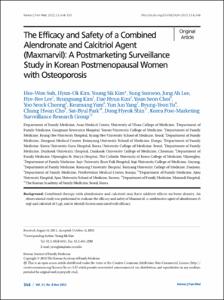KUMEL Repository
1. Journal Papers (연구논문)
1. School of Medicine (의과대학)
Dept. of Family Medicine (가정의학)
The Efficacy and Safety of a Combined Alendronate and Calcitriol Agent (Maxmarvil): A Postmarketing Surveillance Study in Korean Postmenopausal Women with Osteoporosis
- Keimyung Author(s)
- Kim, Dae Hyun
- Department
- Dept. of Family Medicine (가정의학)
- Journal Title
- Korean Journal of Family Medicine
- Issued Date
- 2012
- Volume
- 33
- Issue
- 6
- Abstract
- Background: Combined therapy with alendronate and calcitriol may have additive effects on bone density. An observational study was performed to evaluate the efficacy and safety of Maxmarvil, a combinative agent of alendronate (5 mg) and calcitriol (0.5 µg), and to identify factors associated with efficacy. Methods: A total of 568 postmenopausal women with osteoporosis were enrolled by family physicians in 12 hospitals. The study subjects took Maxmarvil daily for 12 months. Questionnaires about baseline characteristics, socioeconomic status, and daily calcium intake were completed at the first visit. Adverse events were recorded every 3 months and bone mineral density (BMD) in the lumbar spine was measured using dual-energy X-ray absorptiometry at baseline and after 12 months. We evaluated the efficacy and safety of Maxmarvil, and the factors related to BMD improvement. Results: A total of 370 patients were included in final analysis. The median BMD was 0.81 ± 0.12 g/cm2 at pre-treatment and 0.84 ± 0.13 g/cm2 after one year. The average BMD improvement was 3.4% ± 6.4% (P < 0.05), and 167 (45.1%) patients showed improvement. Factors associated with improved BMD were continuation of treatment (odds ratio [OR], 2.41; 95% confidence interval [CI], 1.15 to 5.07) and good compliance (OR, 2.54; 95% CI, 1.29 to 5.00). Adverse events were reported by 35 of the 568 patients, with the most common being abdominal pain and dyspepsia. Conclusion: Maxmarvil was found to be safe, well tolerated and effective in osteoporosis treatment. Continuation of treatment and good compliance were the factors associated with efficacy.
- Keimyung Author(s)(Kor)
- 김대현
- Publisher
- School of Medicine
- Citation
- Hee-Won Suh et al. (2012). The Efficacy and Safety of a Combined Alendronate and Calcitriol Agent (Maxmarvil): A Postmarketing Surveillance Study in Korean Postmenopausal Women with Osteoporosis. Korean Journal of Family Medicine, 33(6), 346–355. doi: 10.4082/kjfm.2012.33.6.346
- Type
- Article
- ISSN
- 2005-6443
- Appears in Collections:
- 1. School of Medicine (의과대학) > Dept. of Family Medicine (가정의학)
- 파일 목록
-
-
Download
 oak-aaa-03414.pdf
기타 데이터 / 226.07 kB / Adobe PDF
oak-aaa-03414.pdf
기타 데이터 / 226.07 kB / Adobe PDF
-
Items in Repository are protected by copyright, with all rights reserved, unless otherwise indicated.